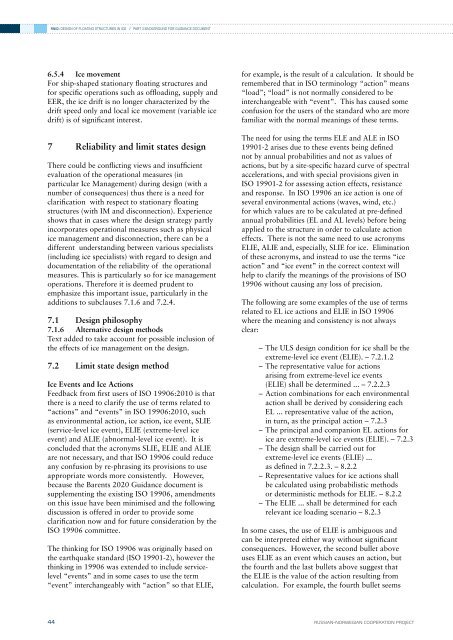phase 4 report - DNV
phase 4 report - DNV
phase 4 report - DNV
Create successful ePaper yourself
Turn your PDF publications into a flip-book with our unique Google optimized e-Paper software.
RN02: DESIGN OF FLOATING STRUCTURES IN ICE // PART 3 Background for Guidance Document6.5.4 Ice movementFor ship-shaped stationary floating structures andfor specific operations such as offloading, supply andEER, the ice drift is no longer characterized by thedrift speed only and local ice movement (variable icedrift) is of significant interest.7 Reliability and limit states designThere could be conflicting views and insufficientevaluation of the operational measures (inparticular Ice Management) during design (with anumber of consequences) thus there is a need forclarification with respect to stationary floatingstructures (with IM and disconnection). Experienceshows that in cases where the design strategy partlyincorporates operational measures such as physicalice management and disconnection, there can be adifferent understanding between various specialists(including ice specialists) with regard to design anddocumentation of the reliability of the operationalmeasures. This is particularly so for ice managementoperations. Therefore it is deemed prudent toemphasize this important issue, particularly in theadditions to subclauses 7.1.6 and 7.2.4.7.1 Design philosophy7.1.6 Alternative design methodsText added to take account for possible inclusion ofthe effects of ice management on the design.7.2 Limit state design methodIce Events and Ice ActionsFeedback from first users of ISO 19906:2010 is thatthere is a need to clarify the use of terms related to“actions” and “events” in ISO 19906:2010, suchas environmental action, ice action, ice event, SLIE(service-level ice event), ELIE (extreme-level iceevent) and ALIE (abnormal-level ice event). It isconcluded that the acronyms SLIE, ELIE and ALIEare not necessary, and that ISO 19906 could reduceany confusion by re-phrasing its provisions to useappropriate words more consistently. However,because the Barents 2020 Guidance document issupplementing the existing ISO 19906, amendmentson this issue have been minimised and the followingdiscussion is offered in order to provide someclarification now and for future consideration by theISO 19906 committee.The thinking for ISO 19906 was originally based onthe earthquake standard (ISO 19901-2), however thethinking in 19906 was extended to include servicelevel“events” and in some cases to use the term“event” interchangeably with “action” so that ELIE,for example, is the result of a calculation. It should beremembered that in ISO terminology “action” means“load”; “load” is not normally considered to beinterchangeable with “event”. This has caused someconfusion for the users of the standard who are morefamiliar with the normal meanings of these terms.The need for using the terms ELE and ALE in ISO19901-2 arises due to these events being definednot by annual probabilities and not as values ofactions, but by a site-specific hazard curve of spectralaccelerations, and with special provisions given inISO 19901-2 for assessing action effects, resistanceand response. In ISO 19906 an ice action is one ofseveral environmental actions (waves, wind, etc.)for which values are to be calculated at pre-definedannual probabilities (EL and AL levels) before beingapplied to the structure in order to calculate actioneffects. There is not the same need to use acronymsELIE, ALIE and, especially, SLIE for ice. Eliminationof these acronyms, and instead to use the terms “iceaction” and “ice event” in the correct context willhelp to clarify the meanings of the provisions of ISO19906 without causing any loss of precision.The following are some examples of the use of termsrelated to EL ice actions and ELIE in ISO 19906where the meaning and consistency is not alwaysclear:––The ULS design condition for ice shall be theextreme-level ice event (ELIE). – 7.2.1.2––The representative value for actionsarising from extreme-level ice events(ELIE) shall be determined ... – 7.2.2.3––Action combinations for each environmentalaction shall be derived by considering eachEL ... representative value of the action,in turn, as the principal action – 7.2.3––The principal and companion EL actions forice are extreme-level ice events (ELIE). – 7.2.3––The design shall be carried out forextreme-level ice events (ELIE) ...as defined in 7.2.2.3. – 8.2.2––Representative values for ice actions shallbe calculated using probabilistic methodsor deterministic methods for ELIE. – 8.2.2––The ELIE ... shall be determined for eachrelevant ice loading scenario – 8.2.3In some cases, the use of ELIE is ambiguous andcan be interpreted either way without significantconsequences. However, the second bullet aboveuses ELIE as an event which causes an action, butthe fourth and the last bullets above suggest thatthe ELIE is the value of the action resulting fromcalculation. For example, the fourth bullet seems44RUSSIAN–NORWEGIAN COOPERATION PROJECT






![Risk Based Pipeline Integrity Management [Compatibility Mode] - DNV](https://img.yumpu.com/50424229/1/190x146/risk-based-pipeline-integrity-management-compatibility-mode-dnv.jpg?quality=85)









